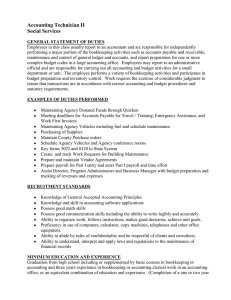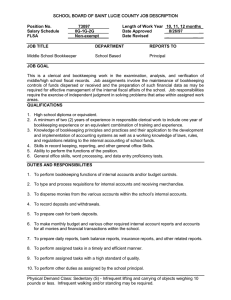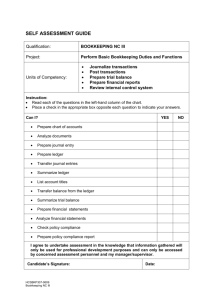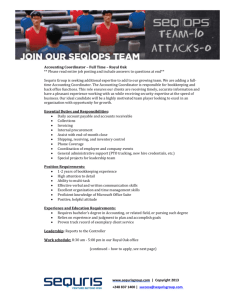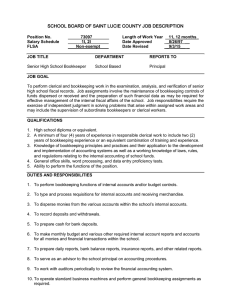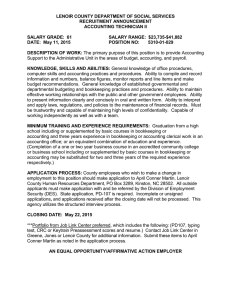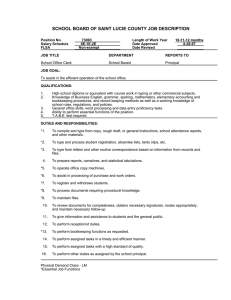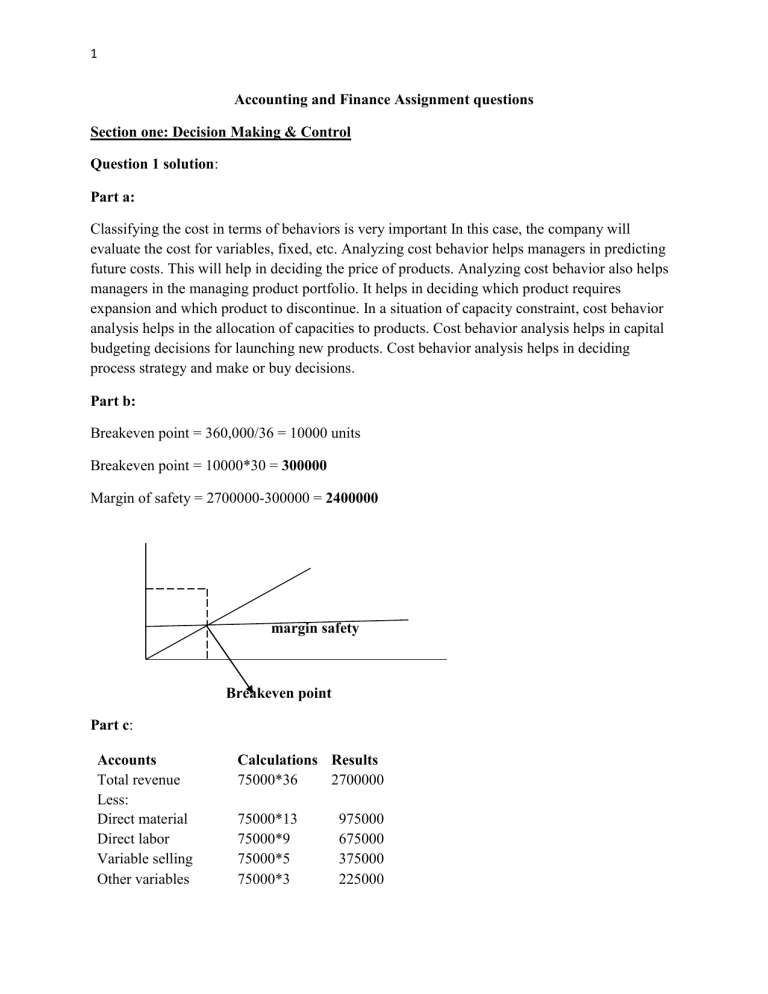
1 Accounting and Finance Assignment questions Section one: Decision Making & Control Question 1 solution: Part a: Classifying the cost in terms of behaviors is very important In this case, the company will evaluate the cost for variables, fixed, etc. Analyzing cost behavior helps managers in predicting future costs. This will help in deciding the price of products. Analyzing cost behavior also helps managers in the managing product portfolio. It helps in deciding which product requires expansion and which product to discontinue. In a situation of capacity constraint, cost behavior analysis helps in the allocation of capacities to products. Cost behavior analysis helps in capital budgeting decisions for launching new products. Cost behavior analysis helps in deciding process strategy and make or buy decisions. Part b: Breakeven point = 360,000/36 = 10000 units Breakeven point = 10000*30 = 300000 Margin of safety = 2700000-300000 = 2400000 margin safety Breakeven point Part c: Accounts Total revenue Less: Direct material Direct labor Variable selling Other variables Calculations Results 75000*36 2700000 75000*13 75000*9 75000*5 75000*3 975000 675000 375000 225000 2 Contribution Less: Total fixed cost Anticipated profit 450000 360000 90000 Part d: Absorption Costing specifies that all the production costs are absorbed by the units produced. The cost of a finished unit in inventory includes direct materials, direct labor, variable and fixed manufacturing overhead, and variable and fixed admin costs. Calculating the full cost under this absorption costing can be done by the following steps: A variable costing statement shows the variable costs and fixed cost separately. In a variable costing statement, Sales Minus Variable Costs give Contribution. This Contribution minus Fixed Costs give Profit. In Absorption Costing Sales Minus, Direct costs minus Manufacturing overhead minus Admin Overhead minus Selling costs give Profit. In Absorption Costing costs are not differentiated into Variable and Fixed Costs. Absorption Costing ignores the difference between fixed costs and variable cost. The Indirect cost like manufacturing overhead and admin overhead and selling overhead is absorbed on a basis such as labor hours, machine hours, etc. Total Cost = Total Direct Cost plus Total Overhead Cost Total Direct Cost = Direct Material Cost plus Direct Labor Total Overhead Cost = Variable Overheads plus Fixed Overheads Part e: Absorption Method No. of Unit Sales Accounts Sales COGS Direct material Direct labor Variable Production Factory Rent Factory power Factory wage Storeroom, wages Total COGS Gross Profit 75000 Per Unit Amount 36 2700000 13 9 3 0.61 0.53 1.6 0.48 975000 675000 225000 46000 40000 120000 36000 2117000 583000 3 Net Income: Absorption Method Accounts Amounts Gross Profit 583000 Less: Operating Exp. Depreciation (28000) Advertising Exp. (38000) Administrative Exp. (32000) Fixed selling & Dist. Cost (20000) Variable Selling & Dits. Cost (375000.00) Total Operating exp. (493000) Net income 90000 Marginal Costing Method Accounts Selling Price Less: Direct materials Direct labor Variable Production overhead Variable Selling & Dist. Costs Contribution margin Amounts 36 -13 -9 -3 -5 6 Net Income: Marginal Costing Method Total production 91000 units Total sales 75000 units Fixed cost for 91000 units Fixed cost for 75000 units Accounts Total Contribution Total Fixed cost Net Income Part f: 360000/91000 0.395604396 29670.32967 Per Unit Amount 6 450000 29670 420330 4 Cost-plus markup is a method is used when the transferor accumulates all the costs via direct as well as indirectly associated with his supply and fixes a percentage of the cost as margin. This margin is computed after considering all risks and rewards associated with the supply. It is simple and less costly too. On the other hand, fixing Market price as the transfer price involves complications and it may be costly to collect the data. Moreover, it may leave very less for the transferee to make a profit. Thus they may find it indifferent to buy from an outsider rather than from the transferor. Part g: Particulars Direct materials Direct labor Variable overhead Fixed overhead Total Full Cost per unit Plus : Mark Up -30% Transfer price Marginal-cost plus Amount 975,000 675,000 225,000 20,000 2,700 22,500 1,920,200 270000+91000 361000 Part h: Advantages of pricing approach: 1. Since the price of the product or service for which the transaction is made is fixed in advance, the buyer does not have to worry about the upward rise in the costs of key components such as materials, labor, etc. 2. Any increase in costs has to be borne by the seller as it will be paid a fixed price for the services as a part of the agreement. 3. Also, in most of the fixed-price contracts, the time of delivery is also decided in advance, therefore, in case of any delay or cost of using additional labor, raw materials, storage cost, transportation cost, etc. has to be paid by the seller of product or service. Disadvantages of pricing approach: 1. If the prices of certain commodities can go up, it is also possible for the prices of certain commodities to go down, bringing the overall cost of providing the service down. In such a scenario, the buyer of the service cannot ask for a reduction in prices of the service and will have to pay the pre-decided fixed price for the service as a part of the contract. 5 2. Another disadvantage of a fixed-price contract for the buyer is that the buyer agrees to pay a certain price for a product or a service without even looking at the actual product or experiencing the service. 3. The buyer has to be very sure of the quality standards of the supplier/service provider before committing a price as a part of the contract. Question 2 Solution: Part a: Budgeting is one of most important tools for any organization in terms of business management. It solves 3 main purposes: Forecasting income and expenses ( and thus profitability) It is a vital tool for decision making It helps in monitoring business performance A company prepares various budgets for several reasons and importance and it includes direct labor cost budget and sales budget. Importance of Direct Labor Cost Budget It shows the total direct labor cost and the number of labor hours required for production. It helps the management to plan the labor force requirements and delegations accordingly. It is an important component of a company's master budget. It is also important since direct labor cost directly affects the operating income of a company. Importance of Sales Budget A sales budget reflects a company's master plan for revenue generation. It has two elements. Revenue element looks after and forecasts sales in units and value while the expense element predicts and studies the costs related to the sales. It helps to create goals for an organization and the staff. Regular budgeting helps the management analyze the various costs and how they affect the sales of the company. It gives a fair idea of how much a company will earn in a given period and with this knowledge they can work of improvising in required dimensions to generate better revenue. Part b: Variable Cost per Unit as per High Low Cost Method = (Highest Cost - Lowet Cost) / Units of Highest Cost - Units of Lowest Cost) = ($128,500- $ 106000) / (1550 Units - 51250Units) = $ 250,000 / 300 Units 6 = $ 22500 per Unit Part c: Flexible Budget 75000 36 No. of Unit Sales Sales price Sales COGS Direct material Direct labor Variable Production Factory Rent Factory power Factory wage Storeroo, wages Total COGS Total expenses Gross Profit Less: Operating Exp. Depreciation Advertising Exp. Administrative Exp. Fixed selling & Dist. Cost Variable Selling & Dits. Cost Total Operating exp. Net income 13 9 3 0.61 0.53 1.6 0.48 2700000 80000 40 3200000 975000 675000 225000 46000 40000 120000 36000 2117000 975000 675000 225000 46000 40000 120000 36000 2117000 583000 1083000 -28000 -38000 -32000 -20000 -375000 -493000 90000 -28000 -38000 -32000 -20000 -375000 -493000 590000 Part d: Budget padding in a bottom-up budget approach can be mitigated by promoting cohesion among the departments and asking all the stakeholders to prepare their expense-revenue estimation for the benefit of the organization as a whole. They should also be asked to while preparing their budget organizational objectives should be kept in mind. Under budget padding, a designed budget is inflated deliberately when submitting for approval to gain larger income than budgeted and making the expenses lesser than in actual budget. A practice of understating the revenues and overstating the expenses is used. 7 Part e: For me, the managers should be evaluated based only on costs and revenues that they control. Hence, in managerial accounting, the design and use of management control systems have a significant influence on an individual as well as making the decision. Moreover, the responsibilities centers are identifiable sections within thin the organization whereby different managers have accepted authority and accountability. Therefore, responsibility centers outline exactly what assets and activities each manager is responsible for. Question 3: Social Accounting is an execution that maintains and helps authoritative exercises just as the human exercises that occur in an association. Accordingly, bookkeeping is a social usage that aides and influences people's conduct in firms and society, consequently affecting the lives of individuals, just as hierarchical and social working and advancement. Specialized bookkeeping is the practice that is inside the association (Gray, 2002). Social accounting helps in determining and reporting people who encompass the customer base, on its usage of resources, emission of pollution, and other factors that affect the environment and society as a whole. An organization conducts business using resources which belong to the environment, any undesirable effect needs to be controlled and proper utilization is needed to make them equally available to the future generation. Specialized bookkeeping just influences Professionalization's administrative, staff, and different exercises inside the organization. Social accounting reveals the details regarding how a company is contributing to society. Business is a socio-economic activity and it should possess some responsibility towards society. Social responsibility ensures that employees and other people related to the business are protected by certain laws. It also ensures that those people are accountable to local agreements (Gray, 2002). Social responsibility enables the society to have a transparent vision regarding the drawbacks and other merits of a business. When the certification of social accounting standards is obtained from the supplier, then more protection of the rights regarding the business is ensured. Social responsibility is efficiently accomplished only when the communication and relationship between the company and the community are healthy. Social accounting is the concept of presenting the impacts of the organization's economic activities on society and the larger community. It is necessary since sustainability is a major issue and along with positive financial impact, a good impact on society, environment, and community is a must for the organization to ensure sustainable growth (Gray, 2002). On the other hand, technical accounting manages the examination and utilization of those practices for an association and the investors. The idea of a communist arrangement of the general public, social liberties, biological preservation bunches, and ecological security, enlarging readiness of network to the corporate social commitment, have contributed towards 8 creating noteworthiness of Social bookkeeping. Conversely, specialized aptitudes have added to the development of associations (Gray, 2002). The destinations of social bookkeeping are to gauge and advise the overall society concerning social government assistance rehearses performed by the associations and their effects on society. Technical bookkeeping thinks about the consequences for the investors and the association. For instance, the revealing of fiscal reports is for the overall population, which is social bookkeeping while specialized aptitudes rehearsed are for the association and the investors. Social bookkeeping is a declaration of an organization's social obligations. Technical accounting helps the board defining the right systems and projects, dissimilar to the social bookkeeping that is worried about the overall population. Through social bookkeeping, an association demonstrates that it isn't socially exploitative as a result of good societies and ecological corruption. Specialized bookkeeping improves representative inspiration due to contending specialized abilities. Social bookkeeping is particular from assessment in that it is an inside produced measure whereby the association itself shapes the social bookkeeping measure its expressed goals. Specifically, it expects to include all partners simultaneously. It estimates social and natural execution to accomplish improvement just as to report precisely what has been finished. There are some key elements in social bookkeeping by which everybody can comprehend the contrast between social bookkeeping and traditional bookkeeping. The primary focal point of social bookkeeping is chiefly on issues which can build up a relationship in the middle of society and association. In most extreme angles, social bookkeeping isn't concentrating on money related information however some of the time it needs monetary information for making a report. The motivation behind social bookkeeping is to be obligated to an enormous number of partners. On the off chance that social accounting is acceptable, at that point, all the perspectives and records of all fundamental partners will be reflected. In great social bookkeeping, the correspondence is fundamentally twopath interchanges with the principle partners. Great social bookkeeping contrasts distinctive period's information and different associations and makes the connection with outside guidelines. In great social bookkeeping, all the different territories of associations have appeared. In great social bookkeeping, changes are additionally occurred because of the changing of a partner's desires. In reality, great social bookkeeping tends to make over the great parts of partners. Decent social bookkeeping consistently makes connections in the middle of the framework and systems to control and gauge the viable systematization cautiously. With the assistance of good social bookkeeping, everything partners can get a short depiction of the apparent multitude of records and reports. They can get every one of these reports based on their requirements. In all qualities of good social bookkeeping, one of the most significant attributes of social bookkeeping is to help constant improvement. That implies great social bookkeeping consistently urges an association to create and expand its improvement persistently and it additionally encourages an association to develop its territory of appraisal (Kaya & Yayla, 2007). Technical accounting upgrades the certainty of the investors of an association, not at all like the social bookkeeping that improves the certainty o the overall population. Social accounting is worried about the utilization of social resources, while specialized bookkeeping is identified with 9 hierarchical assets. It underscores the relationship between a firm and society, dissimilar to the specialized bookkeeping that centers around the association. Social bookkeeping decides the allure of the firm in the network (Kaya & Yayla, 2007). It additionally underscores social expenses and social points of interest while the other practice just stresses authoritative expenses and advantages. Change in the cost accounting system will result in high resistance in an organization because even though the cost accounting is a technical matter still the employees and other stakeholders will resist it because the cost accounting determines the costs of all the products or anything which is in and produced by organization in such a manner to reduce the costs incurred and profits maximized. Thus internal stakeholders of an organization are effected and are aware of the importance of cost accounting. Any change will lead to initial high resistance because the system of costing adopted determines the costs of the organization (Kaya & Yayla, 2007). References 1. Gray, R. (2002). The social accounting project and Accounting Organizations and Society Privileging engagement, imaginings, new accountings and pragmatism over critique?. Accounting, Organizations and Society. 27. 687-708. 10.1016/S03613682(00)00003-9. 2. Kaya, U. & Yayla. (2007). Remembering Thirty-five Years of Social Accounting: A Review of the Literature and the Practice. University Library of Munich, Germany, MPRA Paper. Retrieved from https://www.researchgate.net/publication/24113520_Remembering_Thirtyfive_Years_of_Social_Accounting_A_Review_of_the_Literature_and_the_Practice Section two: Financial Accounting & Accountability Question 1 Solution: Statement of profit or loss for the year ended 31 December 2019 Accounts Amounts Revenue 15032793 Less: Return Inward 325432 10 Total Revenue COGS Gross Profit Salaries & Wages Sales Team Commission Motor exp. Rates Light & Heat Carriage inwards Advertising General exp. Discount Allowed Insurance less prepaid (21937-6225) Allowance for receivable (5%) Provision for audit fees Interest on Debenture (12%) Loss on sale of motor vehicle Dep. On building Dep. On motor vehicles Dep. Fixture & furniture Dep. On office equipment Total expenses Profit/loss Before income tax Income tax Profit/Loss after income tax 14707361 7492132 7215229 1835308 603681 853762 122457 104804 125219 565494 86514 74187 15712 33524 136573 288000 36459 14432 115722 38705 20609 5071162 2144067 753157 1390911 Statement of Financial position for the year ended 31 December 2019 Non-current assets Fixed assets Land 800000 Building 721583 Motor vehicles 736805 Fixture & Furniture 387054 Office equipment 138967 Less: Accumulated dep. Building -171753 Motor vehicles -466788 Fixture & Furniture -211646 Office equipment -56531 Total non-current assets 1877691 11 Current Assets Inventory Trade receivable Cash in hand Bank balance Other current assets Total current assets Total assets 2009480 3656391 2935 446535 6225 6121566 7999257 Equity & Liabilities Share capital Retained earnings Profit during 2019 Share premium Total equity Noncurrent liabilities Long term borrowing Current liabilities Trade payable Current tax payable Short term borrowing Tax liability Other current liabilities Total current liabilities Total liabilities Accounts Purchase Return Outward Opening Inventory Closing Inventory COGS 1120000 565481 1390911 311563 3387955 2400000 850753 753157 607393 2211303 7999257 Amounts 8201311 186654 1486955 2009480 7492132 Disposal Asset Building Accumulated % of dep. Deprecation Method Cost Cost 2 Cost 721583 157321 - Dep. Accumulated For Dep. Net value 2019 564262 14432 12 Motor vehicles Fixture & Furniture Office equipment 30 RBM 10 Cost 20 RBM 920726 3877054 138967 408528 183921 172941 35922 - 57462 385739 115722 214113 38705 103045 20609 Question 2 Solution: Part a: Business Entity In this case, I would choose the Sole proprietor entity. The sole proprietorship is the best to start an own business because sole proprietorship provides the independence to the owner and as an owner is the objective is to have authority over the business then the owner should not look for partnerships or corporation or LLCs as it will limit the authority of the owner in making decisions for the business. Since a proprietorship is not a separate entity under the tax laws, the taxable entity would be the sole proprietor, and the profits of the business or profession are taxed at rates applicable to individual taxpayers, depending upon the income tax slab of the proprietor (Gray, 2016). The business profits also enjoy the advantages of tax breaks and deductions available to the owner. Therefore the enterprise is spared of the sometimes harsh corporate tax rate. A sole proprietor is defined as the type of business unit that is characterized by being owned and run by one person; whereby he or she is solely responsible for all the operations that go on in the business. On the other hand, a partnership is the type of business unit that is characterized by being owned and run by more than one person; to a limit of twenty people. Thus, considering salon, if it is being run and owned by one individual, then it is considered as a sole proprietorship. If it is run and owned by more than one individual, to a limit of twenty, then it is considered as a partnership (Gray, 2016). The type of business is determined by the number of people that are in control of the salon. Thus, a salon can be either a partnership or a sole proprietorship; dependent on the number of people behind its operations. Sole proprietors cannot use words such as 'company', 'corp.', 'inc' etc in their fictitious names as these names imply legal structure and are restricted for naming in sole proprietorships. These terms are only available for the companies that are incorporated and using such names is only permissible for companies with more than one owner. I choose this kind of business entity due to the following reasons: It offers tax benefits and it is easy to claim the business profits and losses at the time tax filing. The sole proprietorship is taxed by applying individual income tax rates. Operating as a sole proprietorship have overall direct control in business decision making and has all the freedom to run the business. Knowing that the most important advantage of having a Sole Proprietorship is that an individual proprietor owns the whole property and manage the business (Rutherford, 2011). He/she is only liable for all transactions. He/she pays taxes from his/her business income which is a part of personal income tax also. The profits from the restaurants can be enjoyed fully because of single 13 ownership. The business deal can be set and the operation can be done as a single owner as to where need not answer to anyone on the decision needs to be taken for business growth and development. The easy way to set a business can be done through the sole proprietor, as there is no legal or less legal action needs to be taken on registration and business start-up. There is no need for the formal setting of the business if there is the sole proprietor and handling the tax and other issues would be simple. In a sole proprietorship, a single person will have all the liabilities of the company including the debts and losses. But here I want to reduce these liabilities and at the same time develop the business as well with the development of more apps. I want to form a new business because I know that there is a demand in the market for the apps I develop. At the same time, I also need to get into a business where I will not be held responsible if the company goes under loss at any stage of the business. I need to do this to be on the safer side of the business. The best option I have to form a general partnership with another company that is also an in-app development business. This will reduce the liabilities and they will be limited only to the company resources and investment. A sole proprietor should keep records for at least 6 years in a machine used 100% for the business. However, a shorter period of 3 years is allowed for taxation purposes for tax-related documents by the IRS. But in a machine which is used for 100% 6 years is standard. In this case, I need only my income tax as in sole proprietorship all the profit earned by proprietorship will be transferred to the owner. Which is the need to be paid by the individual so it is considered as his income. References 1. Gray, B. (2016). For Profit Enterprise in Medicine. Institute of Medicine. Retrieved from https://www.ncbi.nlm.nih.gov/books/NBK217897/ 2. Rutherford, K. (2011). Choosing a Business Form. Dollars & Sense, 51(11), 22. Retrieved from www.overdrive.com; Proquest Part b: The users like Investors, Managers, Employees, etc. need to access the financial statements like Balance Sheet, Income Statement, Cash Flows Statements, Statement of Retained earnings, etc. to know about their vertical requirements like the investors need to know the financial position of the company whether to invest in that company or not, or Investors will come to a clear picture whether how the company's retained earnings and distribution of dividends for some years in past. Managers need to know about how the company is performing its regular operations to generate more profits, making expected sales or providing services, etc (Valente & Crane, 2010). Other users including investors and Managers are also looking at the cash flows statement to know how the company is managing and operating its cash and related activities. Hence, all the users are very much in need to look at the financial statements to know the financial position of a company and the users of financial statements make use of the data that is 14 being reported in financial statements for investing, taking decisions internally, etc (Rutherford, 2011). 1. Needs from financial statements to owners The proprietors give assets to running the association. They utilize fiscal reports for getting significant data. The employments of budget summaries to proprietors are given underneath.: Enable to know the money related position, development, etc. of the business; Help to settle on choices on whether to purchase new offers or sell the offers previously bought; Help to know whether their assets are in effect appropriately used; Enable to know the profit paying limit of the organization. 2. Needs from financial statement to Management A business entity is overseen by proficient chefs. For dealing with the issues of the organization they require significant data. Budget reports flexibly significant data to directors. Fiscal summaries fill in as "eyes and ears to management". The employments of money related administration are summed up underneath: Help to take strategy choices and deal with the business proficiently. Help to evaluate the exhibition of the subordinates. Enable to plan and control the tasks of the organization. Help to assess the presence of the organization, gauge future incomes. 3. Financial statement to suppliers and creditors The providers of products and ventures (or leasers) are keen on the liquidity position of the organization. Budget reports are helpful to them. The budget reports to providers and leasers are given below. Help to know the monetary position, particularly the liquidity position of the organization (ie, to know whether the organization can pay the sum because of them in time). Help to comprehend the drawn-out progression of the business. 4. Financial statement to banks Investors, debenture holders, and different moneylenders give credit to an organization to obtain cash from debenture holders, banks, and monetary establishments. The banks get important data about the reliability of the organization from budget summaries. The employments of fiscal summaries to moneylenders are given underneath. 5. Financial statement to workers Representatives are intrigued to know the productivity and security of their organization. Their compensation and compensation and different advantages are reliant on the money related state of the venture. They utilize budget summaries to the monetary position, development possibilities, etc. of the organization. The fiscal summaries are valuable to representatives in the accompanying manners (Valente & Crane, 2010). Helps to get to the gainfulness and 15 dependability of the undertakings. Help the expected workers to conclude whether to join the undertaking or not. Enable to request more wages, rewards, and so forth. 6. Financial statement to Customers Clients likewise are keen on the issues of an organization. They get data about the productivity of the organization from its budget reports. Subsequently, fiscal reports are valuable to clients. The employments of fiscal reports to clients are as per the following: Help to think about the nature of the item, cost, etc and whether they get inventive products, after-deals administrations, and so forth. Helps to know whether the flexibility of merchandise and enterprises will be standard with no interference. 7) Financial statement to the administration Budget reports are useful to the administration moreover. The employments of fiscal reports to the legislature are given below. Assist to figure charge arrangements. Help the duty specialists to survey the available pay (Rutherford, 2011). Provide measurable information in surveying the public pay. 8) Financial statement to people in general Ventures influence the overall population from multiple points of view. Fiscal reports give important data to general society. The employments of fiscal reports to general society are as per the following: Help to evaluate whether the organization improves the success of the locale. Help to comprehend whether the organization gives greater work openings. Enable to know whether the organization unduly misuses normal assets, dirties and debases nature, abuses work, and so forth. Help to know whether the organization is doing its social duty. References Valente, M. & Crane, A.(2010). Public Responsibility and Private Enterprise in Developing Countries. California Management Review. 52. 52-78. 10.1525/cmr.2010.52.3.52. Rutherford, K. (2011). Choosing a Business Form. Dollars & Sense, 51(11), 22. Retrieved from www.overdrive.com; Proquest 16 Question 3: Part a: For Coniston Convenience Store Ltd: Net income: 80000- 10000 = 70000 ROE Ratio: 10000/70000 = 14% For Hedon Handy Store Ltd Net income: 120000- 9000 = 111000 ROE Ratio: 15000/111000 = 14% Part b: Return of equity is one of the key financial ratios as it measures the return earned by the actual common shareholders or equity holders of the company. ROE tells that how much return % the company is generating for the capital invested by the equity shareowners (Alamry & Mashkour, 2020). Revenue management is the effective management of revenue of a firm by ensuring it focuses on ways and means to increase the revenue. Effective revenue management improves the financial performance of the firm in the below aspects: Increase in revenues increases the profitability of the firm which is considered as the most important metric of financial performance. Pricing of the products or services is a core aspect of revenue management and directly impacts financial performance. Inventory management is another aspect of revenue management that focuses on inventory control to ensure holding costs and shortage costs are reduced (Alamry & Mashkour, 2020). Operating performance ratios like net profit margin and return on total assets can be used to interpret how well the company is performing and generating revenue in comparison to the assets used. The financial risk of a company can be analyzed using ratios like interest coverage ratio and leverage ratio. The ratios of a company can be used to compare that of other companies in an industry to get a better understanding of financial health. It can be compared with those of previous years to see how the company is progressing. The purpose of using ratios is to evaluate management performance in profitability, efficiency, and risk. It is a form of financial statement analysis. It is used to project future performance. Liquidity ratio like current ratio, cash ratio, and quick ratio measures how liquid a company’s assets are compared to its liabilities. The turnover ratio helps to understand how long it will take to convert receivables and inventory to cash and pay its suppliers. Financial leverage is described as the debt-equity ratio of a company. Depending on the capital structure and cost of funding for the company, there is optimal leverage at which the company's net income, and consequently, the company's ROE will increase. As debt financing increases (up to a certain point), the tax benefit 17 of the debt shield and hence, the net profit increase (Alamry & Mashkour, 2020). Additionally, if the debt earns more than its cost (which is usually low for debt), it again boosts the net profit. This leads to an increase in ROE. Increasing debt beyond a point can lead to a risk of default as interest payments can become too big. It can be a precursor to bankruptcy, as well. Additionally, as debt increases, investors perceive the company to be riskier so overall, the cost of capital for the company increases and the stock price can plummet. Return on Equity or ROE is a good profitability ratio but this ratio is good for stable business or the business which is in the market for at least 5 years or more than that. The Start-up business has so many uncertainties about the product's demand in the market and its internal company management policies as well. One startup business has to set a successful marketing plan, operation plan, distribution plan, internal management's efficiency, and innovations to make a business successful. It may happen that in the first year the company has a very high ROE but in the subsequent year it may encounter fierce competition and lose market share and thereby ROE will drop. Hence, for a start-up business in addition to good ROE management's strategy for future, R&D, operational efficiency, marketing, and distribution plans need to be taken into account to call it a successful or potential successful company. Reference Alamry, S., d & Mashkour, S. (2020). ANALYSIS OF FINANCIAL STATEMENTS. Retrieved from https://www.researchgate.net/publication/338385318_ANALYSIS_OF_FINANCIAL_STATEMENTS
